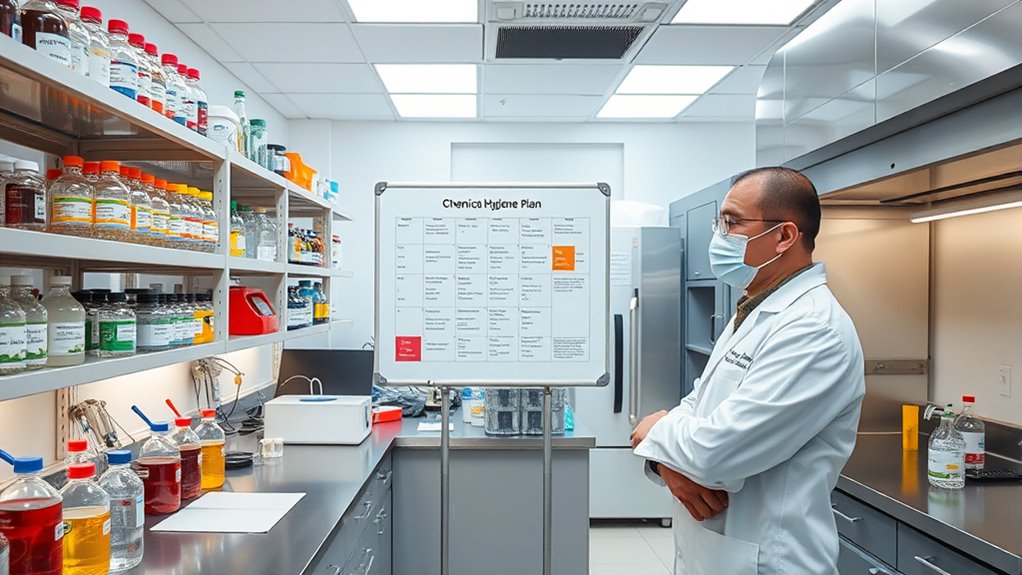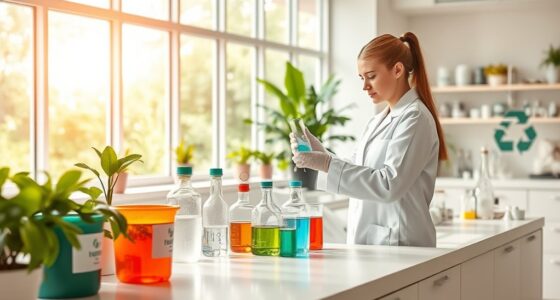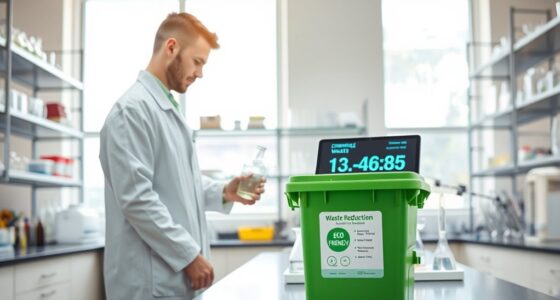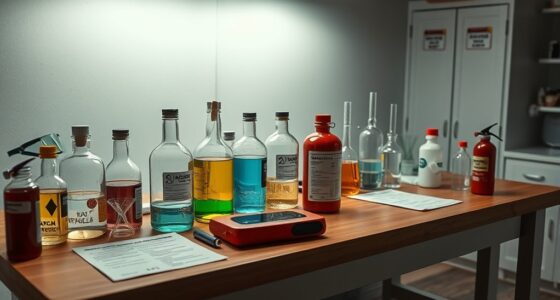To create a Laboratory Chemical Hygiene Plan, you should start by identifying hazards and evaluating risks associated with your chemicals. Develop clear safety policies, including procedures for handling, storage, disposal, and emergency response. Use proper labeling, guarantee safe storage practices, and provide training for your team on chemical safety. Regularly review and update your plan to stay compliant and maintain a safe environment. Continuing with this process will help you build and strengthen your safety protocols further.
Key Takeaways
- Conduct thorough hazard identification and risk assessments for all chemicals in the lab.
- Develop and regularly update safety policies, procedures, and training programs for chemical handling.
- Implement proper chemical storage, labeling, and handling protocols to prevent accidents.
- Establish waste management procedures and emergency response plans for chemical spills and exposures.
- Promote ongoing safety culture through regular reviews, equipment maintenance, and staff training.
Assessing Laboratory Hazards and Risks
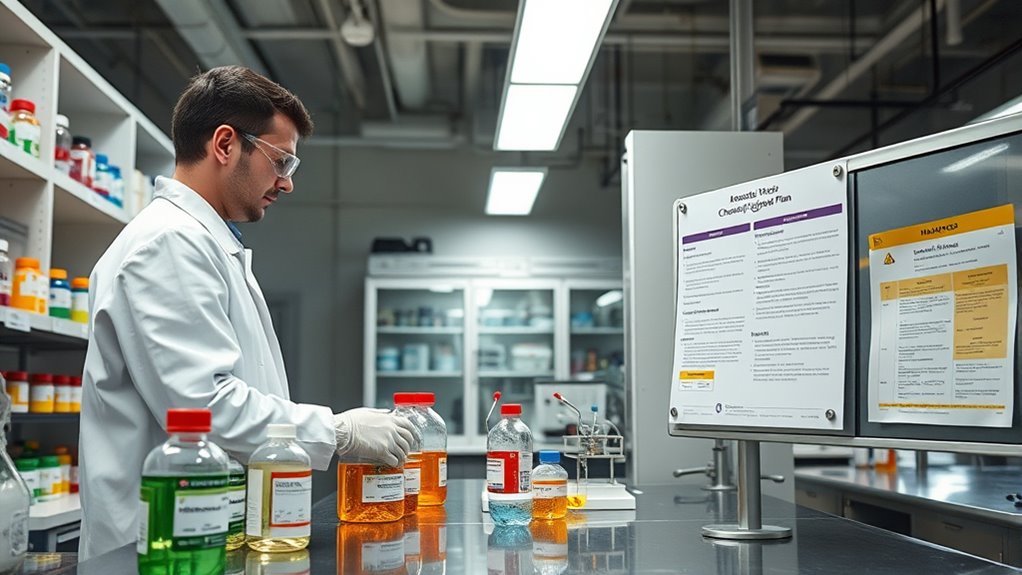
Before you can develop effective safety procedures, you need to identify potential hazards and assess the risks in your laboratory. Start by recognizing sources of chemical exposure, such as spills, leaks, or improper handling. This helps you determine which chemicals pose the greatest risk to you and your team. Evaluating these hazards enables you to prioritize safety measures and prepare for emergency response situations. For instance, if a chemical is highly toxic or volatile, you’ll need specific protocols to contain spills and protect personnel. Regularly reviewing your lab’s chemical inventory and monitoring exposure levels will keep you aware of evolving risks. Incorporating lab safety culture into your daily routines encourages proactive hazard management and reinforces safety commitments. Establishing a strong safety culture promotes continuous safety improvement and accountability among team members. This proactive approach guarantees you’re ready to respond swiftly and safely, reducing the chance of accidents and health issues. Understanding the importance of inspirational safety culture can motivate your team to stay vigilant and committed to safety practices.
Developing Safety Policies and Procedures
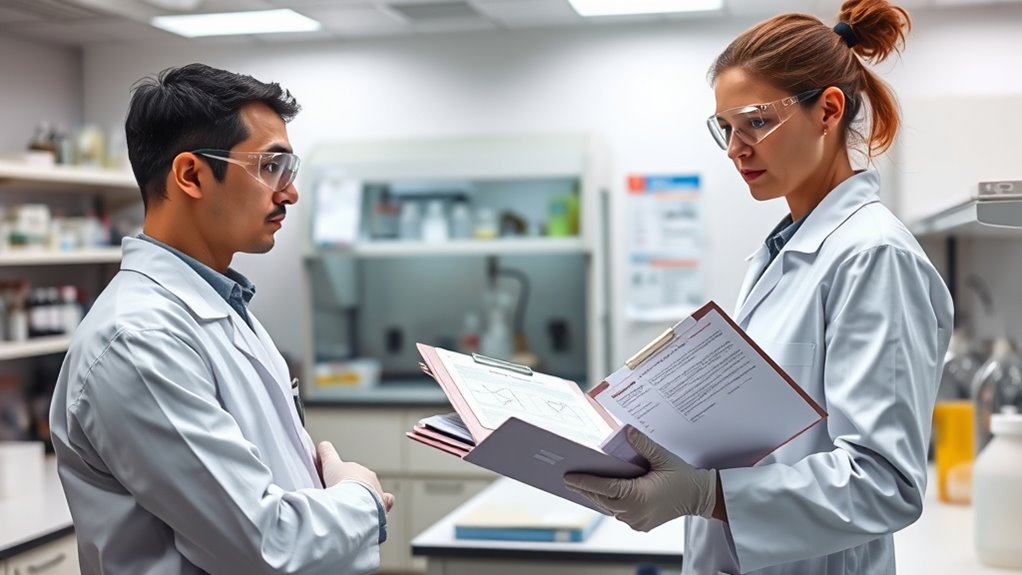
Once you’ve identified the hazards present in your laboratory, the next step is to establish clear safety policies and procedures. These should outline how to respond to chemical spills, ensuring everyone knows their role during a spill response. Effective policies also enhance emergency preparedness, so you can act quickly and safely in various situations. Develop procedures for handling chemicals safely, including proper disposal and cleanup methods. Make sure policies emphasize wearing appropriate personal protective equipment and following proper labeling protocols. Regularly review and update these policies to reflect new hazards or regulations. Clear, well-communicated safety policies create a safer lab environment and help prevent accidents, ensuring everyone understands their responsibilities during emergencies and routine operations. Incorporating lab safety protocols into your plan can further strengthen your chemical hygiene practices. Additionally, implementing chemical exposure controls can mitigate risks associated with hazardous substances, and consulting regulatory guidelines ensures compliance with legal standards.
Establishing Proper Chemical Storage and Labeling
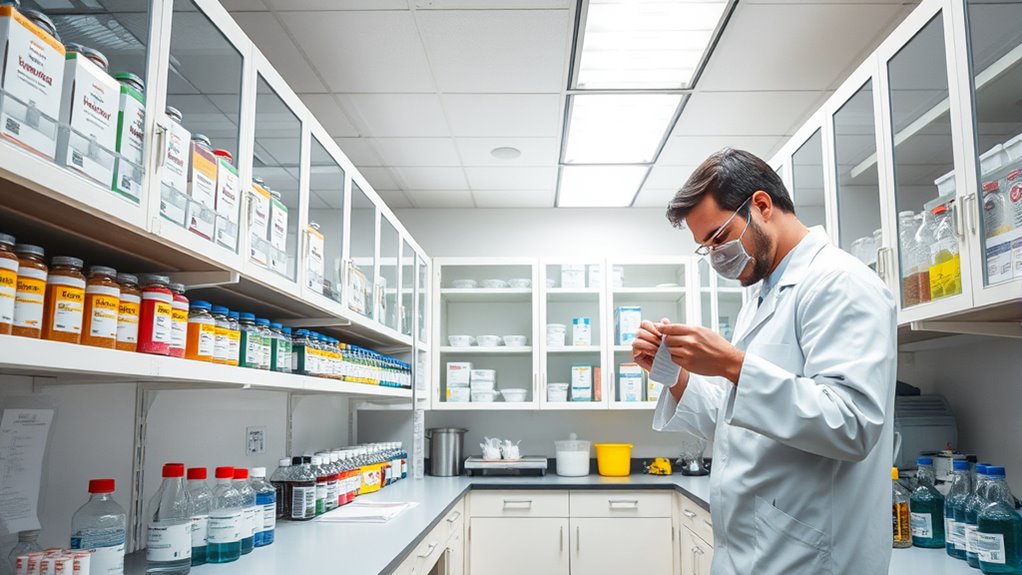
You need to guarantee chemicals are stored safely to prevent accidents and contamination. Implement clear labeling systems so everyone can quickly identify hazards and proper handling procedures. Proper storage practices and labeling are essential for maintaining a safe and organized laboratory environment. Additionally, consider using chemical safety guidelines to ensure compliance with best practices. Regularly reviewing storage conditions and hazard identification can further reduce risks and promote safety. Incorporating preppy dog names as memorable identifiers can also improve communication and safety in complex storage areas.
Safe Storage Practices
Proper chemical storage and labeling are essential to maintaining a safe laboratory environment. You should store chemicals in appropriate, compatible storage containers to prevent reactions or leaks. Always keep flammable substances in fire-resistant cabinets and corrosives apart from acids and bases. Regularly inspect containers for cracks, corrosion, or leaks to avoid chemical spills. Store hazardous chemicals at eye level or below to reduce accidents, and ensure lids are tightly sealed after use. Keep incompatible chemicals separated to prevent dangerous reactions. When storing chemicals, follow manufacturer instructions and safety data sheets. Proper organization minimizes the risk of spills and makes it easier to access materials safely. Additionally, understanding chemical compatibility is crucial for preventing hazardous interactions. Incorporating automated inventory systems can further enhance safety by tracking chemical storage and expiration dates. Implementing proper labeling practices ensures quick identification and reduces the likelihood of mishandling. Maintaining these practices helps prevent accidents, protects personnel, and keeps your lab compliant with safety regulations.
Clear Labeling Systems
Clear labeling systems are essential for maintaining a safe and organized laboratory environment. Proper chemical labeling ensures everyone can quickly identify substances, reducing the risk of accidents or misuse. You should follow established labeling standards, such as the Globally Harmonized System (GHS), to create clear, uniform labels. Labels must include important information like chemical name, hazard warnings, and date received or opened. Use durable labels and resistant markers to prevent fading or smudging. Consistency is key—apply labels immediately after receiving chemicals and update them if contents change. By adhering to proper chemical labeling practices, you minimize confusion, enhance safety, and support efficient laboratory operations. Clear, standardized labels are a fundamental part of your chemical hygiene plan. Additionally, understanding industry trends helps in implementing best practices for labeling and storage. Regular training on chemical safety procedures ensures all personnel are aware of proper labeling protocols and updates.
Implementing Safe Handling and Usage Protocols
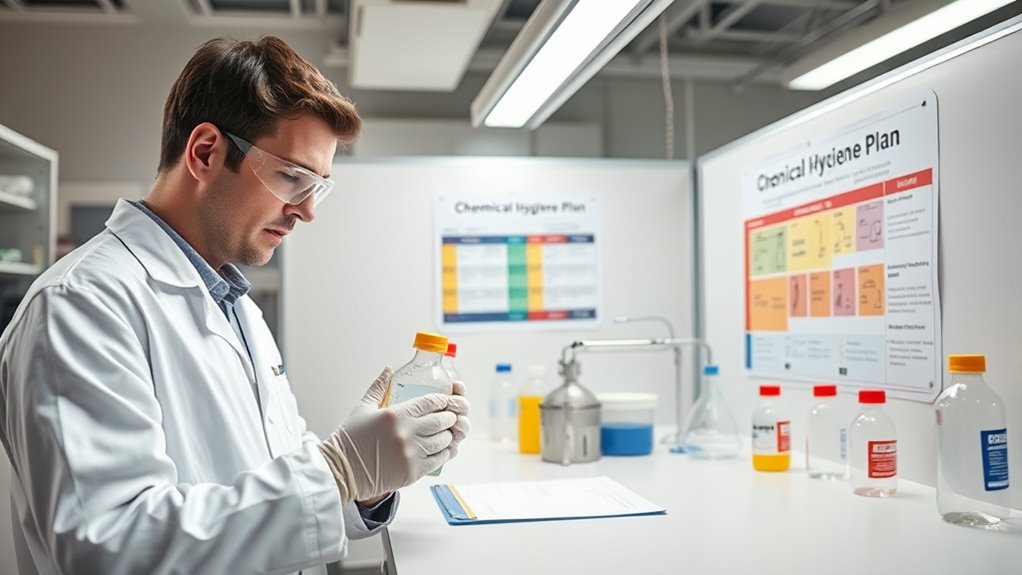
You need to follow proper handling procedures to minimize risks when working with chemicals. Make certain you understand and adhere to usage and storage standards at all times. Doing so helps protect yourself, others, and the environment from potential hazards. Being aware of regional variations in cotton candy flavors and colors can also inform safer handling and storage practices for specialized ingredients. Additionally, understanding air quality management can assist in maintaining a safe laboratory environment by controlling airborne pollutants and ensuring proper ventilation. Consulting headphone compatibility information can help ensure that safety equipment and communication devices function correctly in the lab setting.
Proper Handling Procedures
Implementing safe handling and usage protocols is essential to guarantee accidents and assure laboratory safety. You must follow proper handling procedures to minimize risks and protect yourself. Always wear appropriate personal protective equipment, including gloves, goggles, and lab coats, to shield against spills or splashes. Know the emergency response plans and know how to act quickly if a spill or exposure occurs. Handle chemicals in well-ventilated areas, and avoid eating or drinking near hazardous substances. Use containers properly, labeling them clearly for easy identification. Be attentive to waste disposal regulations to prevent contamination. Regularly review safety protocols and stay informed about hazards associated with your chemicals. Staying vigilant and prepared keeps you and your colleagues safe. Understanding necessary cookies can help ensure compliance with safety procedures and improve overall laboratory management. Additionally, staying updated on hazard communication standards ensures that you are aware of the latest safety information and regulatory requirements. Being familiar with chemical storage guidelines further helps prevent accidental reactions and exposures.
Usage and Storage Standards
Proper usage and storage of chemicals are essential to maintaining a safe laboratory environment. Always follow designated protocols for handling chemicals, ensuring containers are labeled correctly and stored in appropriate conditions. Use personal protective equipment, like gloves and goggles, to minimize exposure during handling. When a chemical spill occurs, respond immediately with your chemical spill response plan, containing and cleaning the spill safely. Store reactive or incompatible chemicals separately to prevent accidents. Regularly inspect storage areas for leaks or damaged containers. Keep access restricted to trained personnel only. Properly labeled storage cabinets and secure shelving help prevent accidental exposure or spills. Being aware of relationship dynamics can help in understanding how to effectively communicate and respond to potential safety issues among team members. Additionally, understanding the psychological aspects of safety behavior can encourage better compliance with safety protocols. Implementing safety training programs enhances overall awareness and preparedness. By adhering to these standards, you reduce risks and promote a safer, more organized lab environment.
Ensuring Proper Chemical Waste Management

To guarantee safe and compliant chemical waste management, it’s essential to develop clear procedures for identifying, segregating, and disposing of hazardous materials. Proper chemical disposal prevents environmental contamination and ensures safety. Establish designated waste containers for different chemical types, clearly labeled and sealed. Regularly inspect and maintain spill response kits to handle accidental releases promptly. Keep detailed records of waste disposal activities to demonstrate compliance. Be prepared for spill response scenarios by training staff on containment and cleanup procedures. Proper waste segregation reduces reactions between incompatible chemicals, minimizing hazards. Always follow local regulations and institutional policies for waste handling. Effective waste management safeguards personnel, the environment, and your lab’s reputation.
- Use labeled, compatible waste containers
- Segregate chemicals by hazard class
- Regularly review spill response plans
- Document waste disposal activities
Training Laboratory Personnel on Chemical Safety
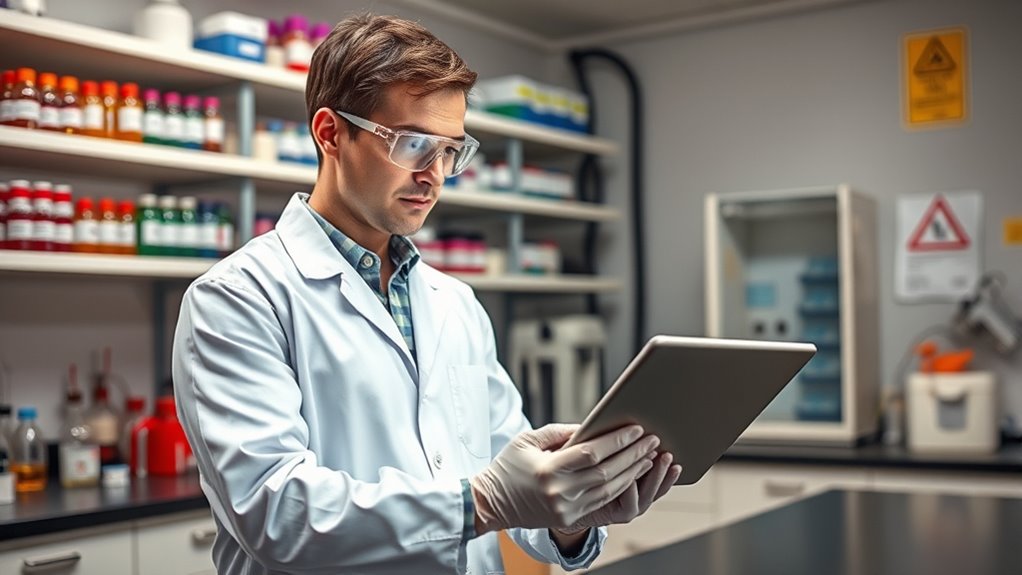
Training laboratory personnel on chemical safety is essential to maintaining a secure and compliant environment. Proper training guarantees everyone understands hazards involved in chemical synthesis and how to handle chemicals safely. You should emphasize safe practices, like proper labeling, storage, and disposal, to prevent accidents. Incorporate lessons on PPE use and emergency procedures to reinforce safety protocols. Additionally, your training should promote good laboratory aesthetics, such as keeping work areas clean and organized, which reduces risks and improves overall safety. Regular training updates keep staff aware of new hazards and procedures. By prioritizing exhaustive safety training, you help create a culture of safety where chemical risks are minimized, and laboratory integrity is preserved. This proactive approach benefits both personnel and the laboratory’s compliance status.
Maintaining and Reviewing the Chemical Hygiene Plan
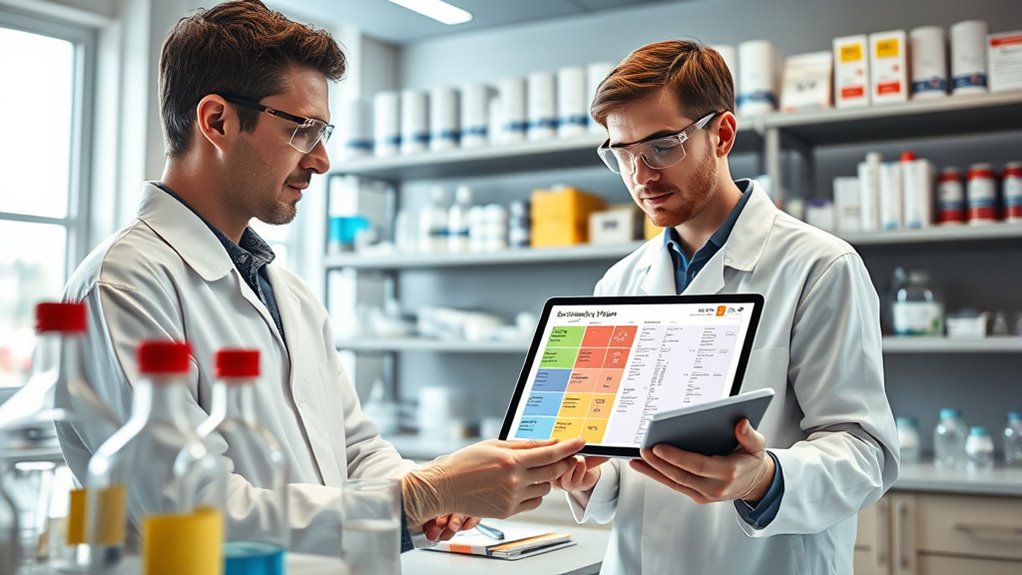
Regularly maintaining and reviewing your Chemical Hygiene Plan guarantees it stays effective and compliant with current safety standards. This process helps you identify gaps in emergency preparedness and ensures equipment is functioning properly. Schedule periodic reviews to update procedures, incorporate new safety guidelines, and address any incidents or near-misses. Conduct routine equipment maintenance to prevent failures during emergencies and ensure accurate safety data. Training updates should accompany plan revisions, keeping personnel informed. Regular drills and audits help verify the plan’s effectiveness. Keep documentation of all reviews, maintenance, and training activities for accountability. By staying proactive, you minimize risks, enhance safety, and maintain a compliant laboratory environment.
- Assess and improve emergency preparedness strategies
- Schedule routine equipment maintenance
- Update safety procedures regularly
- Document review and training activities
Frequently Asked Questions
How Often Should the Chemical Hygiene Plan Be Reviewed?
You should review your chemical hygiene plan at least annually to keep it current. Regular reviews ensure your chemical inventory management is accurate and up-to-date, helping you identify potential hazards. During these reviews, update safety protocols and conduct staff training if needed. This proactive approach minimizes risks and keeps everyone informed about best practices, making certain your laboratory remains compliant and safe for all personnel.
What Are the Common Signs of Chemical Exposure?
When considering chemical exposure, you should be familiar with common chemical signs and exposure symptoms. These include skin irritation, redness, or burns, as well as eye redness, tearing, or blurred vision. Breathing issues like coughing or shortness of breath can also indicate exposure. If you notice any of these signs or symptoms, it’s vital to alert your supervisor immediately and seek medical attention to prevent further harm.
How Do I Handle Chemical Spills Safely?
When handling chemical spills, you should act quickly and follow spill containment procedures. First, alert others and assess the situation. Use appropriate PPE, and if safe, contain the spill with absorbent materials or barriers. Follow your lab’s emergency response plan, which includes notifying authorities if necessary. Proper spill containment minimizes exposure and environmental impact, ensuring safe cleanup and preventing accidents. Always prioritize safety and know your emergency procedures.
Are There Specific PPE Requirements for Different Chemicals?
You need to select Personal Protective Equipment based on each chemical’s hazards and chemical compatibility. For corrosive or toxic substances, wear gloves, goggles, and lab coats. For flammable chemicals, use flame-resistant PPE. Always check the Safety Data Sheet (SDS) for specific PPE recommendations and verify your gear is compatible with the chemicals you’re handling. Proper PPE reduces exposure risks and keeps you safe during laboratory work.
How Can I Ensure Compliance With Local Regulations?
Think of compliance as steering a river—you need to stay on course with the latest currents. To guarantee you’re following local regulations, regularly monitor updates from regulatory agencies and incorporate these into your procedures. Conduct staff training sessions to keep everyone informed and prepared for any changes. By staying vigilant and proactive, you’ll steer your lab safely through regulatory waters and maintain a compliant, safe environment.
Conclusion
So, after all this planning and safety measures, it’s almost ironic that one careless mistake could undo it all. By diligently evaluating hazards, implementing protocols, and training your team, you’re trying to prevent disaster. Yet, the true irony lies in how easily safety can be overlooked in the rush for results. Remember, a well-crafted chemical hygiene plan isn’t just paperwork – it’s your best defense against turning a lab experiment into a catastrophe.
